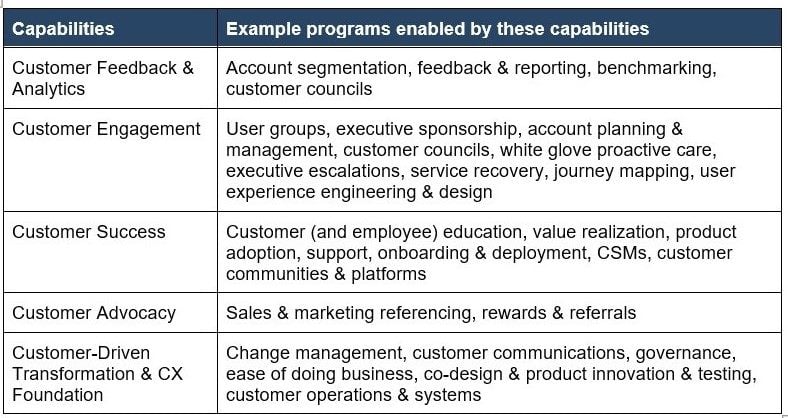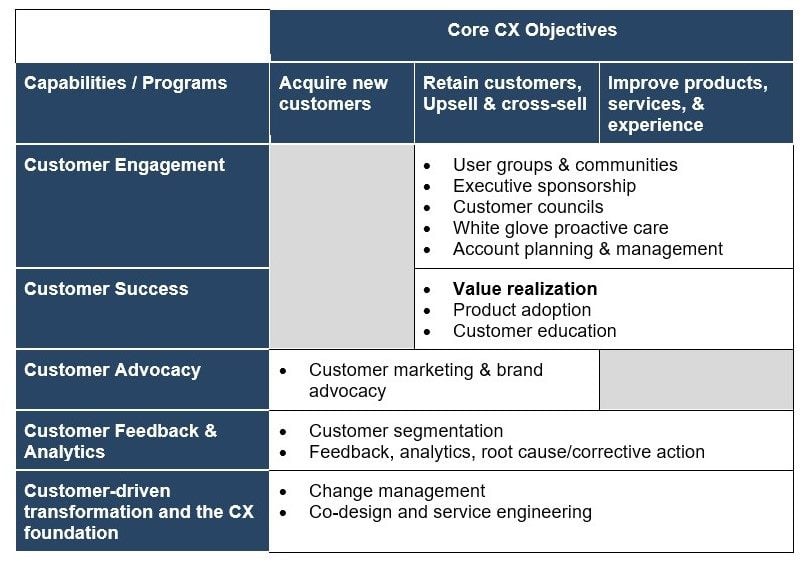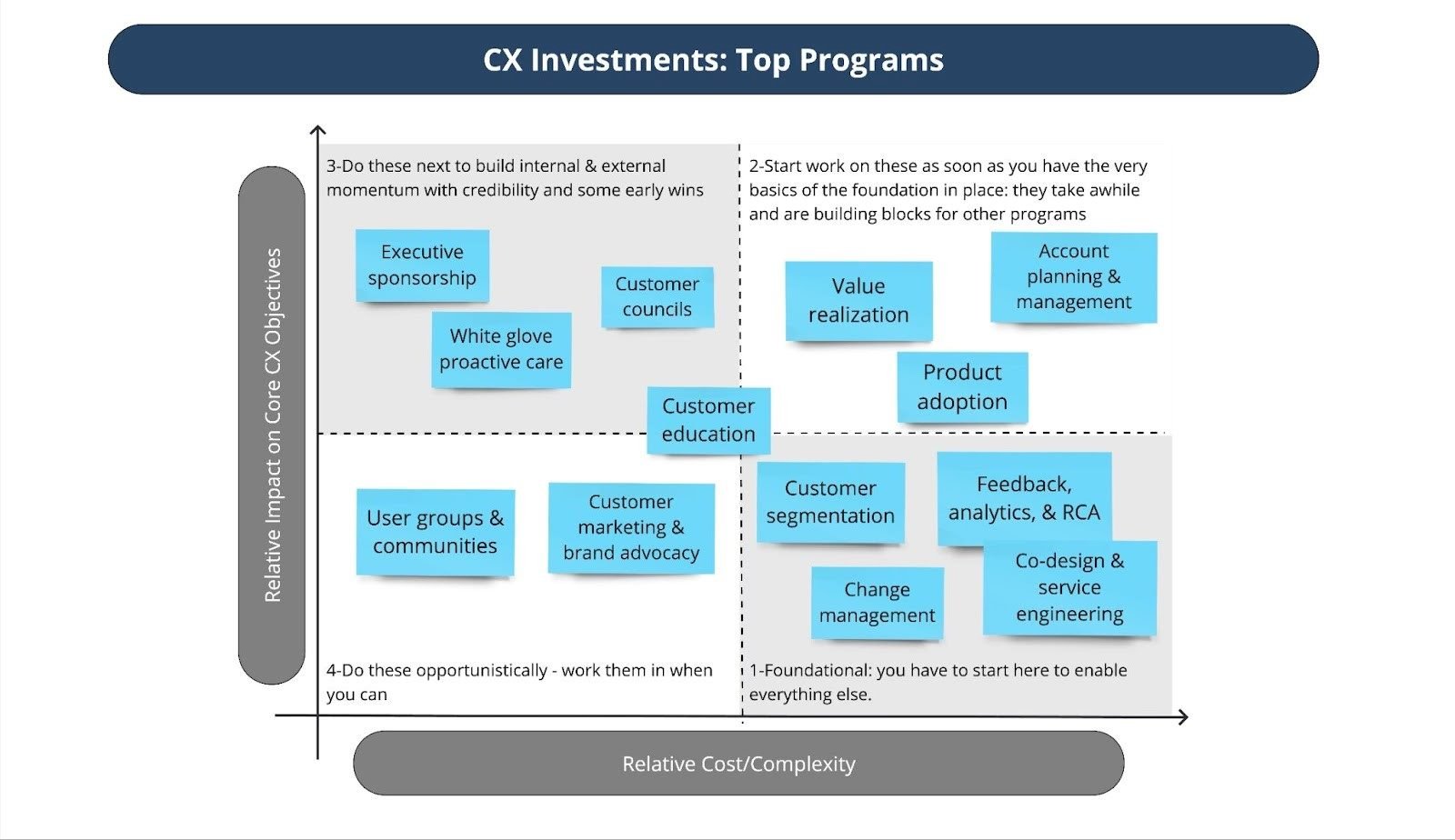The Gist
- Align with business goals. A successful CX strategy requires clear alignment with core business objectives to ensure measurable impact.
- Prioritize capability planning. Effective CX programs need the right capabilities in place, which requires foresight and strategic planning.
- Demonstrate ROI. Showing a clear return on investment is crucial for gaining and maintaining support for CX initiatives.
Investing in a customer experience strategy is fraught with complications and feelings. Most of us in the world of CX are here because we believe that thoughtful CX spending will make an impact on the performance of our company.
If only it were that simple.
When times are tough, CX is frequently chopped indiscriminately and unmercifully. And sometimes this happens rightfully.
The lessons learned in implementing a customer experience strategy as a startup are forgotten or those investments are mismanaged as the business is scaled. And, painful as it may be to accept, we CX leaders often do a lousy job of revealing the straight line between CX and how products (or services) are built and sold.
After all, in an economic turndown or a period of uncertainty, the natural inclination is to cut anything that can't be obviously traced to building or selling. If the straight line is invisible, or worse, not there, that's on us.
Avoiding the Trap of Fuzzy CX Investments: Clarity Over Enthusiasm
All too often, we make CX investments because it's intuitively obvious (to us) that if you drive better customer engagement, only good can result. The "why" of customer engagement is all-too-often a bit unclear. Even if other parts of the organization are enthusiastic participants in new engagement programs, it's still fuzzy most of the time.
The more people are engaged, the higher the visibility, the higher the enthusiasm, the higher the investment — and the higher the fuzziness, as well as the risk of an investment wasted. Think about the best-intended journey mapping project. It might take off like wildfire.
Who doesn't love to see large swathes of the company focusing on customer-impacting business processes? But doing so without a crystal-clear vision of how process simplification helps us build better products or sell more will ultimately yield fatigue, disenfranchisement, resources wasted, failure and even loss of credibility.
Related Article: Effective CX Strategies: Digging out of a CX Standstill
Accountability in CX: Overcoming the Zealot's Blind Spot
It is too easy to blame the company (everyone else), the CFO or the CEO when this happens. More often than not, it's our own fault: we believe that the goodness of CX is obvious. Get people involved with customers, and good things will happen, whether it's a journey map, customer feedback, digital engagement, culture change or any number of other things.
We believe this because we tend to be CX zealots. Speaking as reformed CX zealots, we’ve been as guilty as anyone else in trying to come up with the next shiny new object that will draw people to CX.
And we’ve had our share of situations where we simply couldn't fathom why program X wasn't seen as the thing that would finally shift the company. Without early, tangible deliverables, the attractiveness of our grand visions to those we’ve won over can rapidly fade away. Think about it: We take time-to-value for our customers seriously. Why is it that we so easily lose sight of that for CX investments?
Capability Planning Is Essential
This probably sounds obvious. If you don't have the capability, you can't deliver the program. That means you need time and foresight to prioritize today's capabilities to support your customer experience strategy. To do that you need to think of CX delivery as a set of programs that contribute to building products, selling products or holding onto every customer you have so more products can be delivered to them.
Apply a framework for evaluating how each capability, and each program contributes to those objectives. Defining new programs and lining up the capabilities needed to deliver those programs is challenging. It's a rarity that you and your CX team possess all of the resources needed to execute a program.
Far more often, you rely on capabilities drawing from sales, engineering, marketing, professional services and other lines of business to bring a program forward. This requires discipline, skill and salesmanship.
Finding the right levers to sell a new program internally (and the level of investment therein) might just be the hardest part of the job. Understanding the minimum critical mass of resources that your customer experience strategy needs as a result will help you construct a more compelling case by offering a higher reward-to-risk ratio. This can allow you to sell the vision at a fraction of the up-front cost, and then secure more resources only after the initial investment has yielded real returns. Incremental progression also allows for easier course correction, which in turn helps you ensure that the program is increasingly robust over time.
Related Article: Frictionless Customer Experience: Why Now and What's Next?
Building Momentum in CX: Start Small, Scale Smart
Jennifer Carron is the patient experience officer at BJC Healthcare System and an Experience Alliance Council member. Jennifer suggests that "starting small, failing fast and failing forward will allow you to move at an agile pace, maintain engagement with those supporting the work and minimize your losses — all the while learning throughout the process."
When the minimum viable execution just isn’t that small, a bigger roll of the dice is the only option. In these cases, it’s helpful if a foundation is already laid in the form of smaller, adjacent programs that are valuable on their own. Second order changes can be easier to sell — and execute — when a solid supporting infrastructure is already in place. Beginning with the smaller pieces first wins over the skeptics, builds and maintains momentum, and contributes to smooth execution.
Which programs should you start with? Mileage will vary. Your views will differ based on your business model (e.g., B2B or B2C), industry, scale, competitive threats or stage of maturity.
We tend to organize CX capabilities and programs into five categories:
- Customer feedback & analytics programs
- Customer engagement programs
- Customer success programs
- Customer advocacy programs
- Customer-driven change management & CX foundational programs.
Here are some examples of each:

This is in no way an exhaustive list, but we believe it's representative, especially for B2B businesses.
Integrating CX into Sales: Turning Experience into a Competitive Advantage
In an effort to build a company-wide customer retention and revenue expansion mindset, it is incumbent upon the CX leader to make the actual customer experience part of the sales process. If you can translate your CX performance measures into a simplified point of differentiation between you and your competitors and allow the sales organization to include that experience as part of the sales process, you immediately create value — not just for Sales, but through the role that CX plays in revenue generation.
In short, move the metrics and anecdotes from the shadows of your internal reporting and into the bright lights of a sales presentation. And take that even one step further by requiring sales teams to bring forward data on consumer testing and co-design. Not only will this make it top of mind for a much larger segment of the organization, it drives engagement particularly when the other teams start reaching out and asking, "how are we doing?" and "how can I help?"
A Straight Line Between Your CX Investments and Company Results
In a recent article, we outlined a framework for core CX objectives and programs to execute to meet those objectives. Below, we have mapped specific programs to that framework:

Every one of these programs can be a contributor to customer retention (and follow-on sales), customer acquisition (first time sales) and product development. Some are also foundational for other programs. We have categorized the programs based on, at least in our experience, what the dominant contributions are.
We then assessed each program based on relative impact to building or selling and the relative cost and complexity of deploying the program.
The programs we have evaluated fall into four categories that set the sequence of execution:
- Priority 1: foundational: you have to start here to enable everything else
- Priority 2: start work on these as soon as you have the very basics of the foundation in place: they will take a while and are building blocks for other programs
- Priority 3: do these next to build internal and external momentum with credibility and some early wins
- Priority 4: do these opportunistically: work them in when you can.

Strategic CX Investments: Start Small, Measure Success, Build Momentum
We didn't pick these programs randomly. Each of them has been proven to us time and again to make a big impact on customer outcomes and on our company's financial, strategic and operational objectives. If this feels overwhelming, pick just three programs. But remember that you'll need to start with a foundation before you can build any real successes.
Making responsible CX investments requires more than instinct and enthusiasm. Start by asking why, as in what is the purpose of each CX program. Follow the steps:
Identify the Core CX Objectives
Identify the most crucial programs that will impact the core CX objectives of customer acquisition, retention, sales and product development. Your voice of the customer will be a contributor to this.
Gain Support and Sponsorship
Gain support and sponsorship for those programs and agree on the straight line between how each program is measured operationally, how that impacts the core CX objectives and how that, in turn, affects company financial, strategic and operational objectives. Prepare measures of success for each of them before you begin and share progress as you go.
Build Required Capabilities
Consider what capabilities are required to deploy those programs and start building those capabilities by training, hiring, utilizing AI and other technologies and collaborating with other teams. If it’s possible to do so, consider taking an incremental approach and develop a plan to measure success as you go, before drawing on additional resources.
Focus on Early Wins
Start first with a small number of foundational programs and look at "early wins" that can help build momentum. Within each program, determine the irreducible components and execute them one at a time. Make sure that each brick laid down is a capable foundation for future strategic efforts.
As BJC Healthcares Jennifer Carron asserts, "by using co-design in the experience engineering you will ensure your end users are active members of the foundational program build. This will help you get it right the first time and ensure balance in the service design. For example, not over-rotating on the customer and causing friction for the technology or team providing the service experience and vice versa. It will prevent breakage and ensure a more harmonious experience ecosystem."
Measure and Adapt
Measure and adapt. Continuously evaluate the impact of your CX programs and be prepared to adapt based on feedback and results. Iterative change can help burn fewer resources and less political capital if you need to backtrack and try again.
Prioritize Crucial Programs, Stay the Course and Adjust
The CX investment road can be long and winding. It requires a good map, navigation skills and ongoing course corrections. Sometimes it also requires a willingness to cut your losses and try again. It's important to revisit and adjust your strategies at least yearly and, more likely, semi-annually to ensure they remain aligned with evolving business goals and customer expectations. Patience and small, measurable, strategic bets can help you to build robust, demonstrably valuable CX programs, percentage point by percentage point.
In our experience, there are key programs and capabilities within a customer experience strategy that we know to be successful. But what works for us may not work for you. Select your favorites, integrate them into your customer experience strategy, work through the alignment with the business and the priorities of deployment, and start rounding out your overall CX capabilities right now.
Learn how you can join our contributor community.
